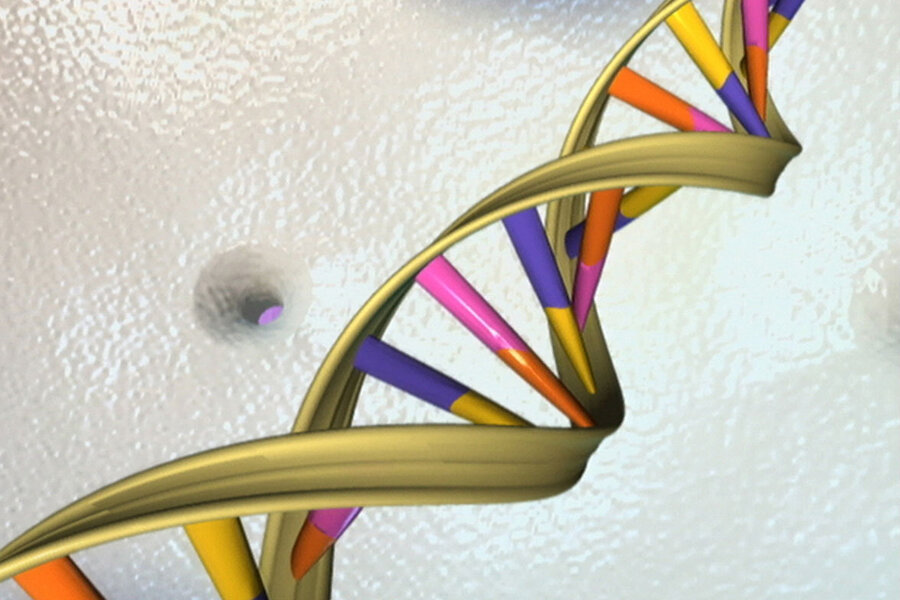Why did Harvard scientists hold a 'secret' synthetic genome meeting?
Loading...
At Harvard Medical School in Boston, 150 hand-picked scientists, lawyers, and entrepreneurs gathered last week – in private – to discuss how to create a genome, potentially even a human one, from scratch in a lab.
Though writing an original chemical blueprint for a human being is a far-off possibility, given that the human genome has a sequence of three billion chemical pairs that make up each person’s unique DNA, the secrecy of the meeting (no tweeting, no media, invite only) alarmed some people who are worried about the ethical questions this type of genetic engineering poses. After all, synthesizing a human genome is becoming cheaper and easier with more advanced technologies.
Such a technique could make it possible, as The New York Times points out, to use a synthetic genome to create, through cloning for instance, human beings without biological parents.
“The creation of new human life is one of the last human-associated processes that has not yet been industrialised or fully commodified. It remains an act of faith, joy, and hope,” Drew Endy, a bioengineering professor at Stanford University, and Laurie Zoloth, a medical ethics professor at Northwestern University, wrote in an essay criticizing the secrecy of the meeting.
“Discussions to synthesise, for the first time, a human genome should not occur in closed rooms,” wrote the two scientists.
They pointed out that topics on last week’s meeting’s agenda included changing the human genome itself.
“For example, could scientists synthesise a modified human genome that is resistant to all natural viruses?” the authors ask.
“They likely could, for purely beneficial purposes, but what if others then sought to synthesise modified viruses that overcame such resistance? Might doing so start a genome-engineering arms race?,” Drs. Endy and Zoloth question.
The meeting was co-organized by Harvard biologist George Church, a celebrated and equally controversial scientist and entrepreneur who “wants to reanimate the woolly mammoth, edit pig genes so their organs can be transplanted safely into people — oh, and reverse aging,” as STAT’s Sharon Begley describes.
Dr. Church told The Washington Post that the meeting wasn’t open to the public or to media because its theme overlapped with a paper written by many scientists that’s pending publication in a major scientific journal. The organizers didn’t want to be accused of "science by press release," reported the Post, so decided not to share their project publicly until they had a peer-reviewed article validating their research.
"It wasn't secret. There was nothing secret or private about it," said Church, who told the Post that the video of the event will be released when the scientific paper is published, likely soon.
Church also said that the project is not aimed at creating people, only cells, and not just for human genomes, despite that an invitation to the meeting at Harvard said that the primary goal “would be to synthesize a complete human genome in a cell line within a period of 10 years,” as the Times reports.
There has been tremendous progress in genomics since scientists finished sequencing the entire human genome in 2003. As the Times reports:
Scientists and companies can now change the DNA in cells, for example, by adding foreign genes or changing the letters in the existing genes. This technique is routinely used to make drugs, such as insulin for diabetes, inside genetically modified cells, as well as to make genetically modified crops. And scientists are now debating the ethics of new technology that might allow genetic changes to be made in embryos. But synthesizing a gene, or an entire genome, would provide the opportunity to make even more extensive changes in DNA.
A team headed by genomics pioneer J. Craig Venter first synthesized the chromosome of one bacterium in 2010 and inserted it into another species, thereby replacing the host species's DNA. The result, named Syn 1.0, was a microbial cell that was able to replicate and make a new set of proteins, powered by its synthetic genome, as the Monitor has reported.






